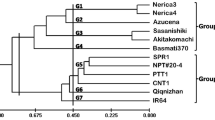Abstract
An essential assumption underlying markerbased prediction of hybrid performance is a strong linear correlation between molecular marker heterozygosity and hybrid performance or heterosis. This study was intended to investigate the extent of the correlations between molecular marker heterozygosity and hybrid performance in crosses involving two sets of rice materials, 9 indica and 11 japonica varieties. These materials represent a broad spectrum of the cultivated rice gene pool including landraces, primitive cultivars, historically important cultivars, modern elite cultivars and parents of superior hybrids. Varieties within each set were intermated in all possible nonreciprocal pairs resulting in 36 crosses in the indica set and 55 in the japonica set. The F1s and their parents, 111 entries in total, were examined for performance of seven traits in a replicated field trial. The parents were surveyed for polymorphisms using 96 RFLP and ten SSR markers selected at regular intervals from a published molecular marker linkage map. Molecular marker genotypes of the F1 hybrids were deduced from the parental genotypes. The analysis showed that, with very few exceptions, correlations in the indica dataset were higher than in that of their japonica counterparts. Among the seven traits analyzed, plant height showed the highest correlation between heterozygosity and hybrid performance and heteorsis in both indica and japonica datasets. Correlations were low to intermediate between hybrid performance and heterozygosity (both general and specific) in yield and yield component traits in both indica and japonica sets, and also low to intermediate between specific heterozygosity and heterosis in the indica set, whereas very little correlation was detected between heterosis and heterozygosity (either general or specific) in the japonica set. In comparison to the results from our previous studies, we concluded that the relationship between molecular marker heterozygosity and heterosis is variable, depending on the genetic materials used in the study, the diversity of rice germplasms and the complexity of the genetic basis of heterosis.
Similar content being viewed by others
References
Bernardo R (1992) Relationship between single-cross performance and molecular marker heterozygosity. Theor Appl Genet 83:628–634
Boppenmaier J, Melchinger AE, Seitz G, Geiger HH, Herrmann RG (1993) Genetic diversity for RFLPs in European maize inbreds III. Performance of crosses within versus between heterotic groups for grain traits. Plant Breed 111:217–226
Charcosset A, Lefort-Buson M, Gallais A (1991) Relationship between heterosis and heterozygosity at marker loci: a theroetical computation. Theor Appl Genet 81:571–575
Dudley JW, Saghai Maroof MA, Rufener GK (1991) Molecular markers and grouping of parents in maize breeding programs. Crop Sci 31:718–723
Godshalk EB, Lee M, Lamkey KR (1990) Relationship of restriction fragment length polymorphisms to single-cross hybrid performance of maize. Theor Appl Genet 80:273–280
Lee M, Godshalk EB, Lamkey KR, Woodman WW (1989) Association of restriction fragment length polymorphisms among maize inbreds with agronomic performance of their crosses. Crop Sci 29:1067–1071
Melchinger AE, Lee M, Lamkey KR, Woodman WL (1990) Genetic diversity for restriction fragment length polymorphisms: Relation to estimated genetic effects in maize inbreds. Crop Sci 30:1033–1040
Messmer MM, Melchinger AE, Herrmann RG, Boppenmaier J (1993) Relationships among early European maize inbreds: II. Comparison of pedigree and RFLP data. Crop Sci 33:944–950
Oka HI (1988) Origin of cultivated rice. Japan Scientific Societies Press, Elsevier, Tokyo
Saghai Maroof MA, Soliman KM, Jorgensen RA, Allard RW (1984) Ribosomal DNA spacer-length polymorphisms in barley: Mendelian inheritance, chromosomal location, and population dynamics. Proc Natl Acad Sci USA 81:8014–8018
Smith OS, Smith JSC, Bowen SL, Tenborg RA, Wall SJ (1990) Similarities among a group of elite maize inbreds as measured by pedigree, F1 grain yield, grain yield heterosis and RFLPs. Theor Appl Genet 80:833–840
Steel RGD, Torrie JH (1980) Principles and procedures of statistics. McGraw-Hill, New York
Tanksley S, Causse M, Fulton T, Ahn N, Wang Z, Wu K, Xiao J, Yu Z, Second G, McCouch S (1992) A high density molecular map of the rice genome. Rice Genet Newsl 9:111–115
Vergara BS, Chang TT (1976) The flowering response of the rice plant to photoperiod: a review of the literature. Int Rice Res Inst Tech Bull 8, Manila, Philippines
Wu KS, Tanksley SD (1993) Abundance, polymorphism and genetic mapping of microsatellites in rice. Mol Gen Genet 241:225–235
Xiao J, Li J, Yuan L, Tanksley SD (1995) Dominance is the major genetic basis of heterosis in rice as revealed by QTL analysis using molecular markers. Genetics 140:745–754
Yang GP, Saghai Maroof MA, Xu CG, Zhang Q, Biyashev RM (1994) Comparative analysis of microsatellite DNA polymorphism in landraces and cultivares of rice. Mol Gen Genet 245:187–194
Yuan LP (1992) Development and prospects of hybrid rice breeding. In: You C, Chen ZL (eds) Agricultural biotechnology, Proc Asia-Pacific Conf Agric Biotechnol. China Science and Technology Press, Beijing, pp 97–105
Zhang Q, Saghai Maroof MA, Lu TY, Shen BZ (1992) Genetic diversity and differentiation of indica and japonica rice detected by RFLP analysis. Theor Appl Genet 83:495–499
Zhang Q, Gao YJ, Yang SH, Ragab R, Saghai Maroof MA, Li ZB (1994) A diallel analysis of heterosis in elite hybrid rice based on RFLPs and microsatellites. Theor Appl Genet 89:185–192
Zhang Q, Gao YJ, Saghai Maroof MA, Yang SH, Li JX (1995) Molecular divergence and hybrid performance in rice. Mol Breed 1:133–142
Author information
Authors and Affiliations
Additional information
Communicated by P. M. A. Tigerstedt
Rights and permissions
About this article
Cite this article
Zhang, Q., Zhou, Z.Q., Yang, G.P. et al. Molecular marker heterozygosity and hybrid performance in indica and japonica rice. Theoret. Appl. Genetics 93, 1218–1224 (1996). https://doi.org/10.1007/BF00223453
Received:
Accepted:
Issue Date:
DOI: https://doi.org/10.1007/BF00223453




